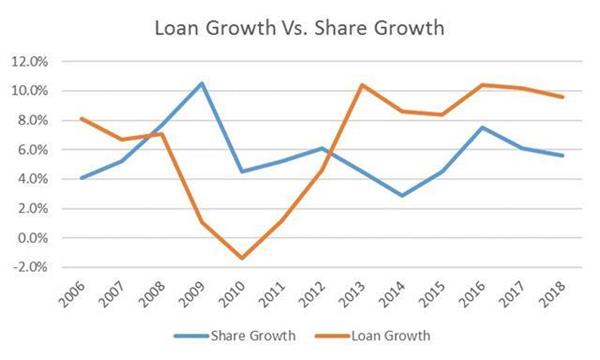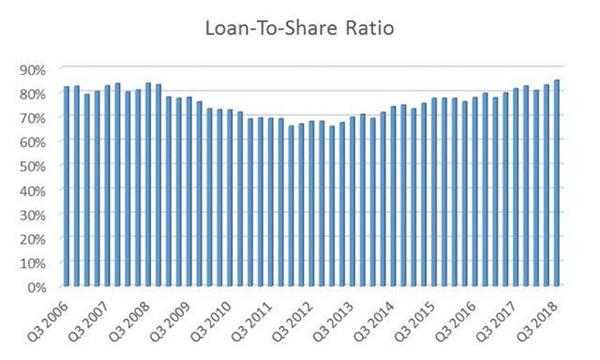The Federal Reserve began increasing interest rates in December 2015. The 25-basis point increase in the Fed Funds Rate in December 2018 marked the ninth such increase in three years. In that same time frame, short-term U.S. Treasury rates moved higher at the same pace. The three-month U.S. Treasury rate was 0.20 percent in December 2015 and increased 2.20 percent to 2.40 percent in December 2018.
Credit union response?
Credit unions, on the other hand, have not increased deposit rates materially. After staying flat for several years, the industry’s cost of funds began slowly increasing in 2017. The cost of funds ratio was 0.64 percent at the end of the third quarter of 2018, up seven basis points from year-end 2017. That’s a far cry from the 225 basis points the Fed has increased rates since 2015 or the 220 basis points that short-term U.S. Treasury rates have increased. But the increase in the cost of funds ratio is notable for 2018.
Most credit unions have approached increasing deposit rates with a wait-and-see attitude, resulting in below-market rates for as long as possible. The wait may be over as a result of tightening liquidity. Loan growth has outpaced deposit growth since 2013, and the result is balance sheets with tighter liquidity profiles. The industry’s loan-to-share ratio topped 80 percent in the third quarter of 2017 for the first time since 2008. At the end of September 2018, the loan-to-share ratio was 84.9 percent. 

Tighter liquidity to drive change.
This scenario – deposit rates lagging market rate increases – has occurred in previous interest rate cycles, as well. The impetus for deposit rates increasing in the past has been tighter liquidity, and tighter liquidity is likely to be the driving force behind higher deposit rates again. As you plan for 2019, make sure strategic discussions consider the possibility of a higher cost of funds and the impact a higher cost of funds would have on the credit union’s margins. Consider whether running “What-if” scenarios would benefit your next ALCO discussion. Some possible scenarios include:
- What if money market rates have to increase 25 percent or 50 percent next year?
- What if more members shift deposits from lower-cost, non-term shares to more expensive term deposits to lock in attractive rates?
- What is the dividend cost of running a CD promotion? What impact would existing members moving funds from non-term shares into CDs as a result of a promotion have on that cost?
- What if deposit rates increase, but asset yields fall, as a result of a flat or inverted yield curve?
Several options are likely available if you find your credit union in need of additional liquidity. Those options include higher deposit rates, CD promotions, selling investments, borrowing, issuing non-member deposits, selling loan participations, and slowing down lending. Catalyst Strategic Solutions’ Advisory Team can help you determine which options are the most advantageous for your institution and business model.